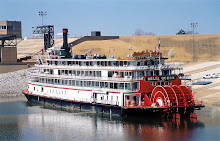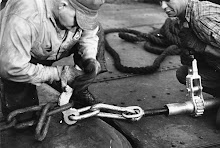Coal mining began in Greene County in the late 1700's with Thomas Hughes of Jefferson. He used his slaves to strip mine coal on his property above Ten Mile Creek . It is believed that much of this was dug in the ravine between the present Jefferson Morgan High School and the football field. Coal mining was limited to small " farmer mines" scattered over the area and it was sold by the bagful. Near the river and larger streams coal was loaded onto flatboats as seen in this old drawing courtesy of Carnegie Museum.
As land transportation was improved from narrow mud paths to rough mud roads so grew too, the business of mining and selling domestic heating coal. By 1868, Mr. R.A. Sayers of Waynesburg was offering " Coal coarse, measure warranted and no disappointment " at 4.00 for a hundred pounds at his Ten Mile Works.
Courtesy of Greene county Historical Society
Local investors ( Dilworth Mining Company 1880-1930) opened Dilworth above Rices Landing in 1902, it was the first large commercial coal mine in Greene County. Other coal patches and company towns built in the early twentieth-century were Crucible in 1912, Rosemary, Penn Pitt and Sandy Run in Monongahela Township. In Dunkard Township were Poland Mines, Maple Sterling and Rose Mine. The Walnut Hill mine was started in West Point Marion in 1916. The William Pitt mine started around 1916 near Clarksville. Below Pollocks Mill was the Patton Mine (1921-1930) , owned by the Waynesburg Coal Company. Built in 1918-19 were Mather, by the Pickands-Mather Company of Ohio and Nemacolin, built by the Buckeye Coal Co. of Ohio. One of the largest company towns was Bobtown, started in 1920 by Jones and Laughlin.
By the WW2 era, the largely untapped coal deposits in Greene County became very important. Increased mechanization had made it possible to mine some more remote portions of the coal vein through extensive underground systems connected to large portals along the Monongahela River. Several large river front complexes were built including Emerald, Warwick, Cumberland and US Steel's huge Robena Mine.
There were basically 12 major coal mines in Greene County, the last of southwestern Pennsylvania's counties to become a major producer. They are:
• Crucible, opened in Cumberland Township in 1913 by Crucible Steel for its mill coal supply. At its peak in 1953, the mine employed 903 miners and produced 1.3 million tons of coal. Crucible Mine closed in 1961 and throughout its 49-year life the mine extracted 36.5 million tons of Pittsburgh seam coal. It was operated later by other firms.
•
Mather started operations in 1918 in Morgan Township by Pickands-Mather Co. of Cleveland. It was the site of a 1928 underground explosion that killed 194. The mine was abandoned in 1965.
Mather Mine by Howard Fogg
Nemacolin Mine by Howard Fogg
• Nemacolin, in Cumberland Township, began shipping its coal in 1919. Nemacolin was said to be the largest coal mine in the U.S. at that time and it was Greene County's second most productive mine in the 1940s. After nearly 70 years of production the mine was idled in 1986 and sealed in 1988.
• Shannopin was a Jones & Laughlin subsidiary operation that began coal production in 1926 in Dunkard Township. It was closed in 1992 and sold.
• Warwick, a Duquesne Light operation opened by Warwick Coal Co. in 1921, closed, then was acquired by the utility firm in 1940. It underlies several townships.
• Robena, in Monongahela Township, began mining in 1944 by H.C. Frick Coke Co. Disaster came to the early, fully mechanized mine in 1962, when a methane gas and coal dust explosion killed 37 miners.
Production ceased in 1983.
• Gateway, formerly
Edward and Emerald, first opened in 1921. It was renamed Gateway in 1963 by a subsidiary of the companies that used its output. The Morgan Township mine closed in 1989.
Dilworth Tipple
• Dilworth, originally opened in 1902, At Rice's Landing, it was the county's first commercial mine. It was a deep shaft mine and had 190 coke ovens and was located along the river on the northern border of Rice's Landing. Coal and coke were loaded directly into barges from the riverside mine.In 1914, the Rice's Landing Coal and Coke Company acquired the Dilworth Mine. Within the next few years, the H.C. Frick Coke Company acquired the mine. It was reopened in 1974 by U.S. Steel, and purchased by Consolidation Coal Co. in 1984.
• Cumberland, in Whitely Township, began production for U.S. Steel in 1977. In 1993, the mine was acquired by Cyprus Arnax and operated by Cyprus Cumberland Resources Corp.
Cumberland's River Tipple at Grays Landing, Eric M. Johnson Photo
• Emerald, opened in 1977 in Franklin Township, was first operated by Youngstown Sheet & Tube Co. It has had several owners since.
• Bailey, in Richhill Township, began operations for Consolidation Coal in 1984. For a short time in 1992, it was the largest underground coal mine in the United States and was known for its efficiency and low cost..
Bailey Mine, Consol photo
• Enlow Fork, also in Richhill, was opened by Consolidation Coal in 1990 and was for a long time the most productive underground mine in the United States.



































